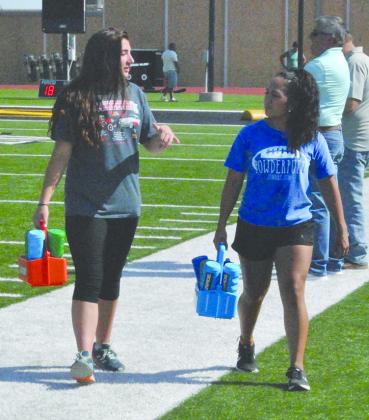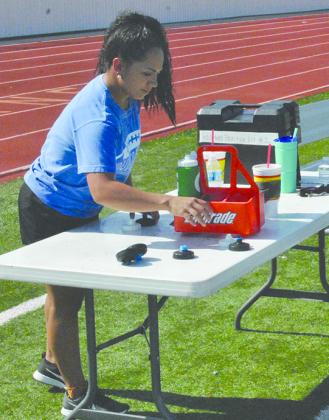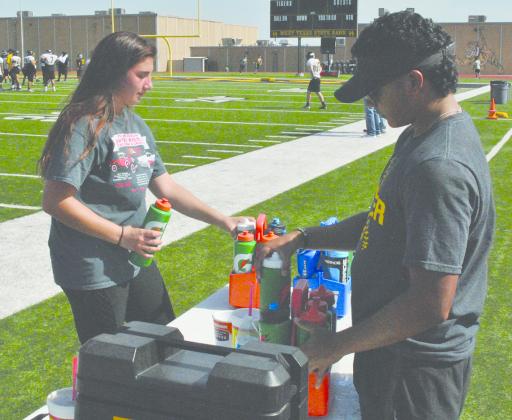More than just waterboys (and watergirls), Snyder ISD student trainers are a first line of defense in preventing anthletes’ injuries
Attend a Snyder ISD athletic event this school year, and chances are you’ll never notice the student trainers, and if you do, you’ll probably dismiss them as the kids who provide water to thirsty athletes.
But to consider them just waterboys (and girls) would be like thinking the president of the United States is just some guy who gets to ride in a really cool airplane — there’s much more to the job description than what’s apparent at first glance.
While they are not allowed to treat injuries, they do just about everything else they can to see that athletes’ needs are taken care of during games and practices.
“They’ve got very important jobs,” Snyder ISD Athletic Trainer Alexandria Marsh said of the eight students under her supervision. “They do everything I can’t do because I have to work with athletes who have been injured. They’re the persons who are behind the curtain, so to speak.”
Student trainers routinely tape athletes’ ankles and knees and can even help injured players with their rehabilitation exercises. Those who take Marsh’s sports medicine classes even have to become CPR-certified.
Perhaps the most important role they serve, however, is as Marsh’s eyes and ears.
Throughout the school year, there will be many times that Snyder High School teams will be competing at multiple locations on the same day. Since Marsh can only be at one place at a time, her student trainers who attend other games are invaluable.
“For example, if I’m working a football game, and they’re working an away volleyball game, I know I can trust them to do their jobs,” she said. “I don’t have to worry about having to baby-sit them or them getting into trouble. They are held to the same standard as the athletes.”
One of the reasons the students become student trainers is they they believe it will give them an entry path into a medical career.
“I want to enter the medical field, and this will look good on my college resume,” said junior Bonnie Jasper, who is in her first year as a student trainer. “I don’t want anyone to get injured, but if they do, I want to be sure I’m able to know what to do.”
Student council president Drevian Hernandez also is a first-year student trainer.
“The main thing is that I want to go into the medical field and this will be good training toward that,” he said. “If I can at least learn the basics, it’ll help me realize my dream.”
Senior Cheyenne Avila, in her second year as a trainer, is the veteran of Marsh’s student staff.
“I used to watch the game from the stands and I’d see (the trainers) helping the athletes,” said Avila, who plans to become a physical therapist or chiropractor. “I figured this would be good training — more hands-on than anything — and (Marsh) is the best teacher ever.”
Being a student trainer was much more complex than what Avila observed from the stands.
“It’s a lot more work than I expected,” she said. “But being able to help the athletes is worth it.”
Standing on the sidelines during football practices under a hot August sun isn’t fun, but Hernandez said the lessons he’s learning this school year are important ones.
“I knew it would be a lot of work, and it was, at first,” he said. “But I think it’ll be second nature to me going forward. So far, it’s everything I hoped it would be. I’m learning something every day.”




